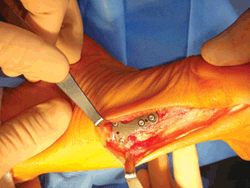Surgeons prefer polyaxial locking plate for hallux valgus
German investigators comparing two locked plates for moderate to severe deformity correction found better results with a locking plate.
 Erik Wilde |
Use of polyaxial locking plates during Lapidus arthrodesis resulted in improved results and fewer complications in patients with moderate and severe hallux valgus deformities, according to results of an award-winning retrospective analysis.
“Polyaxial locking plates should be recommended in the treatment of hallux valgus deformities with metatarso-cuneiform joint instabilities,” Erik Wilde, MD, of the Department of Trauma and Orthopedic Surgery at the University Hospital Lübeck and senior foot surgeon Kai Olms, MD, of the Gemeinschaftspraxis am Kurpark, Bad Schwartau in Germany, told Orthopaedics Today Europe. Wilde and Olms won the Jacques Duparc Award at the 12th EFORT Congress 2011.
Hallux valgus is a common condition marked by pain in the metatarso-cuneiform joint. Yet, the challenge is maintaining minimal iatrogene functional loss. The Lapidus procedure seeks to solve this problem at the site of the deformity. Wilde noted that K-wires, screws and plates are typically used in the Lapidus procedure to create a locking plate system to treat metatarso-cuneiform joint instability in patients with hallux valgus deformities. However, the procedure has been reported to carry a 5.3% to 12% non-union rate, according to Wilde.
Subjective, objective outcomes
|
Image: Wilde E |
For their study, Wilde and colleagues evaluated the outcome of the Lapidus procedure using special locking plates in 128 patients (144 feet) who were treated at a specialized orthopedic center by a single surgeon between 2002 to 2005. For the procedure, the surgeon used the Variax-plate (Stryker) in 70.8% of patients and the TiFix plate (Litos) in 29.2% of patients. The study group included 117 women and 11 men. Sixteen patients had surgery in both feet. Overall, the patients had a mean age of 50 years at the time of the procedure and body mass index of 24.91 at follow-up.
To assess bony union, daily pain, subjective, objective and radiological results, researchers conducted a follow-up of the patients 3 years after the procedure and sent patients a questionnaire that included the Shankar score. The questionnaire had a 78% response rate.
Preoperatively, the investigators found that 77.8% of patients reported pain occurring at least once a day in their affected foot. At follow-up, 87% of the patients had no pain, 7.6% had pain sometimes and 5.3% continued to experience pain. In addition, the Shankar Scoring System showed “good” or “excellent” results in 81.2% of the cases. The investigators also found that the mean hallux valgus angle decreased from 38° preoperatively to 18.8° postoperatively. Although 20% of patients had radiographic evidence of severe arthritis, 50% showed no signs of the condition.
Complications
Eight patients required reoperation, including one due to relapse of hallux valgus, two for non-union and five for removal of hardware. No wound infections occurred, Wilde said.
According to the study abstract, the investigators found two cases of deep venous thrombosis and one case of 5° hallux valgus, which was not clinically revelant.
“In conclusion, we could show a reduction of complications and good results in moderate to severe cases of hallux valgus deformity,” Wilde said. “In the daily orthopedic work, the use of polyaxial locking plates should be recommended to improve the results after intervention. In addition, we have to find other possibilities to shorten immobilization after the procedures and look for other reasons influencing the surgical results.” – by Tara Grassia
Reference:
- Wilde E, Schulz AP, Olms K. Retrospective analysis of hallux valgus therapy by lapidus arthrodesis with polyaxial locking plates. Presented at the at the 12th EFORT Congress 2011. June 1-4. Copenhagen, Denmark.

- Erik Wilde, MD, can be reached at Department of Trauma and Orthopedic Surgery, University Hospital Luebeck, Germany School of Medicine, Lubeck, Germany 23538; 49-173-5315902; email: erik.wilde@uk-sh.de.
- Disclosure: Wilde has no relevant financial disclosures.


